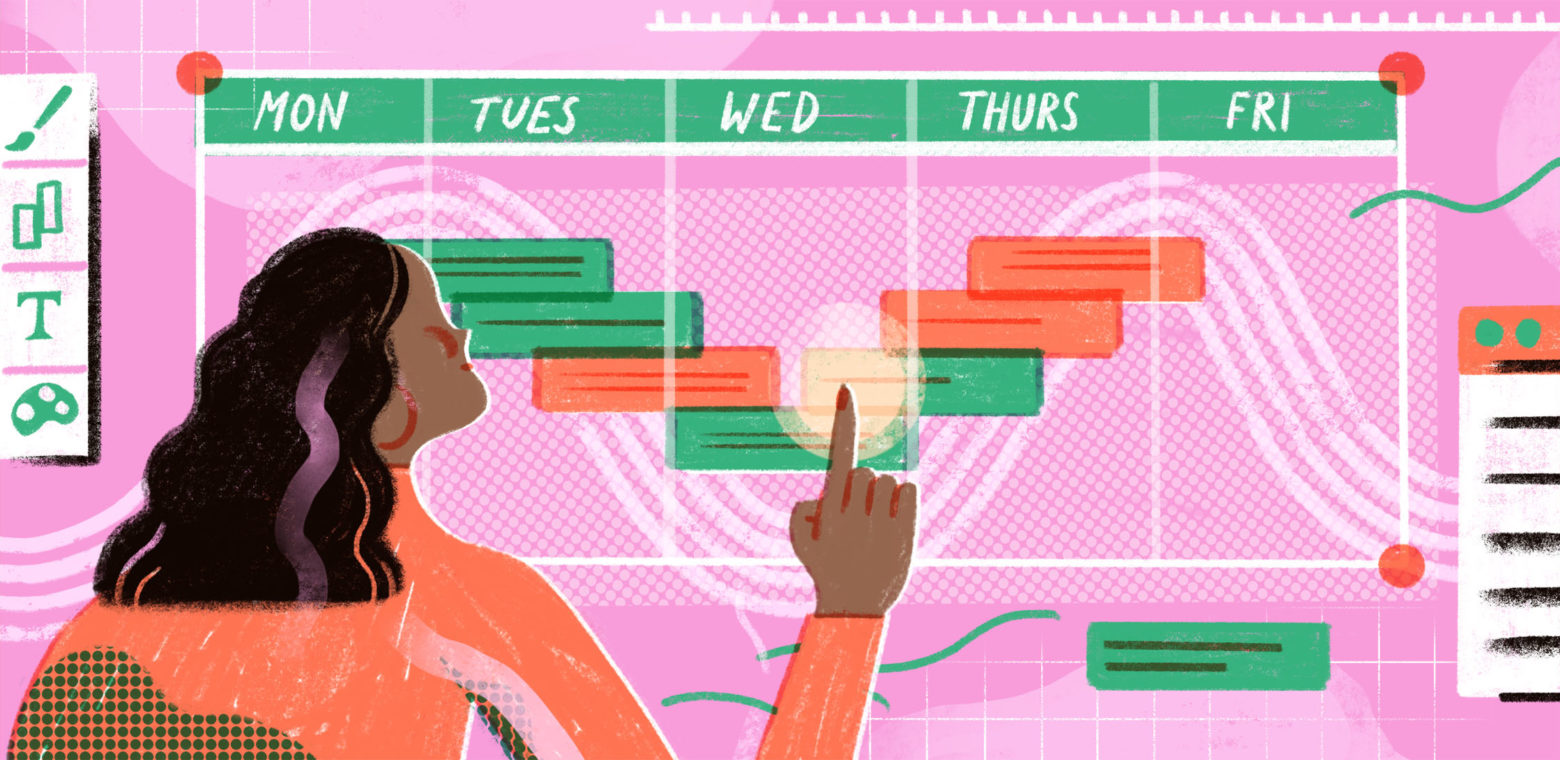Design your ideal workweek and do more of what you love
Use our templates to manage your energy levels and minimize those slumps.
5-second summary
- Your ideal workweek shouldn’t be about getting more work done – it should be about getting work done in a way that makes you feel great.
- Our templates can help identify what drains you versus what energizes you and figure out what work you think makes you feel good – then evaluate how that stacks up against reality.
- We offer a few tactics to help you not only design your ideal workweek, but also live it.
When you get toward the end of your typical workweek, do you find yourself watching the clock, willing the weekend to come sooner? Do you ever look at your untouched priorities and wish you could squeeze another day into your workweek? Is your energy level totally different on Thursday than it is on Tuesday?
If you answered “yes” to any of those questions, you might be stuck in a cycle that not only leaves you ending each week feeling frustrated and frazzled, but could also ultimately lead to burnout.
It’s time to take back some control by identifying your real priorities, setting boundaries, and designing a workweek that helps you tackle the right things – and feel good about it, too.
Your ideal workweek: It all comes back to energy management
Your ideal workweek shouldn’t be about getting more work done – it should be about getting work done in a way that makes you feel great.
Our body experiences ultradian rhythms, biological patterns that repeat numerous times throughout the day. There are peaks when we’re super focused and dips when we feel foggy and distracted.
If your peaks are consumed by meetings, emails, and fire drills, you have no choice but to try to cram creative or deep work into the low points. Not only does that often lead to lower-quality output, but it also makes your workday feel like a major slog.
There are plenty of hacks, schedules, and routines out there that promise to help you get more done. But designing your ideal workweek isn’t about amping up your productivity (although that can be a natural benefit).
Rather, this process is about identifying what drains you versus what energizes you and ensuring that you’re dedicating adequate time to the latter. In short, it’s not just about what you do – it’s about how you feel.
Designing your own ideal workweek: 2 templates to pull it all together
How can you bridge your current reality to your ideal state?
Below are two exercises that we strongly believe in here at Atlassian. Both are split into two parts: figuring out what work you think makes you feel good and then evaluating how that stacks up against reality.
Exercise #1: If you prefer an intuitive approach…
Journaling is a powerful tool for clarifying your feelings and ambitions. This first exercise is all about reflecting on your previous two weeks (or whatever time frame works best for you) and using those findings to plan out what you need to accomplish as well as what you’d ideally experience over the course of the next two weeks.
You’ll start by identifying tasks and responsibilities that give you energy, as well as ones that sap it. It can be helpful to keep a log open on your computer, or even a notepad on your desk, where you can jot down observations about what you’re doing and how you feel as you move through your workweek.
Grab the worksheet
Download the worksheet to get started.
Being in tune with your own feelings sounds simple, but it can be surprisingly complex. Try this: Pay attention to specific sensations you notice when you feel motivated and inspired. Is there a certain part of your body that feels activated? Is there something you want to eat? Do you feel like you need to move? Picking up on those types of bodily cues can help you identify other activities that give you energy.
After you’ve logged those feel-good activities, see if you can spot any themes. Maybe you notice that brainstorming motivates and energizes you – you’ll jot that down in the next section. Aim to identify three top themes from the previous two weeks.
With a better idea of what fills your tank, you’ll move into planning for the next two weeks (or whatever time frame you’ve decided on).
And finally, you’re ready to round things out by balancing emotions with productivity. Looking at your previous two weeks, you’ll categorize what you spent your time on into quadrants based on the priority of those tasks and how much energy they require. Then, you’ll plan out your next two weeks using those same categories (energy and priority).
Revisit this exercise regularly to check in with yourself and ensure that you’re structuring your workweek in a way that supports both your ambitions and emotions.
Exercise #2: If you prefer a quantitative approach…
It’s not always easy to pinpoint what breathes life into your week (and what doesn’t). For those of us who don’t intuitively know what to dial up or down, this exercise is effective for breaking down your week in a more digestible way.
It should be used on a regular basis – ideally by reflecting on the week each Friday and then using that information to plan come Monday.
grab the template
Download the template to get started.
Start at the top of the template, where you’re asked to leave your responses to several thought-provoking questions about what an “ideal” workweek means to you. Your answers to those questions provide important context before you get further into the details of reflecting and planning.
Next, you’ll work backwards. At the bottom of the template, you’ll see a section for reflections. These are questions that you should ask yourself on a weekly basis, preferably on a Friday when you’re wrapping up your week. Using that chart, you’ll jot down your responses as any actions that you could potentially take the following week.
Come Monday morning, you’ll revisit the template (and your answers to the above questions), this time with an eye on planning for the week ahead. The template splits your priorities into two distinct sections: life priorities and work priorities.
You’ll list your top three priorities for each in the designated chart. Then, identify the tasks you need to do to work toward those priorities and categorize those tasks based on the type of work (e.g. deep work, light work, or commitment).
After that, you can plan out your schedule knowing that you’re planting the seeds for an energized week, rather than repeating old patterns that don’t serve you.
Taking the leap from ideal to reality
Figuring out what invigorates you and what exhausts you and building your workweek around those realities are important parts of the process.
But it still begs the question: How do you move the workweek of your dreams from paper to practice? You can’t start avoiding emails and shirking responsibilities, so how do you actually put these new findings into action?
Here are a few tactics to help you not just design your ideal workweek, but live it:
- When you’ve figured out your preferences and goals, openly share those with the people you work with – from managers to peers – whether that’s through a meeting, a Confluence page, instant messaging – whichever communication method you’re comfortable with. This transparency equips your colleagues with the knowledge they need to better support you (and avoid throwing your workweek off track).
It’s a great exercise I have used both personally and with my team, the latter of which brings alignment and team focus. It’s the combination of reflection and forward-looking that allows us to not only deliver on our goals but also continuously improve how we do it together.
Jurgen Spangl, Chief Experience Officer
- Figure out what to do with the tasks that drain you. Most of us don’t have the luxury of eliminating them from our workdays entirely, but setting boundaries can prevent them from monopolizing your week. You could also connect with your team to talk through those responsibilities. Maybe you could divide that work more evenly, or perhaps there’s someone on your team who enjoys that type of work and wants to take it off your plate.
- If you’re a manager, implement this ideal workweek exercise as a team-wide activity so that everybody feels empowered to take the reins and work in a way that energizes them.
‘The most precious resource we have is time.’ Steve Jobs. If managers take on the responsibility of implementing this practice across their teams, your team will gain actionable learnings that create real momentum.
Sarah Atkinson, Chief of Staff
- Proactively block out time on your calendar for the work that means the most to you, so you can feel confident that you have the time you need. This is especially important when working in an organization where other people have access to your calendar, as those outside obligations can quickly monopolize your time.
What we know is there will always be too many demands on your time, and to unleash your potential you need to invest in how you use your time, ensuring it is spent on the highest priorities.
Carrie Gray, Ops PgM and creator of our quantitative approach to identifying your ideal workweek
- Create a resource that reminds you of what makes you excited about your job. Maybe it’s a “feel-good folder” where you’ll keep nice emails and compliments that coworkers sent to you. Or perhaps you’ll screenshot customer reviews and shuffle them out as your screensaver. It’s a seemingly small change that ties you back to your purpose and gives your spirits a boost when you need it.
We might need to see a photo or hear a name uttered to remind ourselves of how much we enjoy someone in our lives. Similarly, we might need visual cues to fuel our work tanks. And those cues won’t just appear consistently in our workweeks unless we create that system.
Christine Dela Rosa, Brand Lead, Ways of Working and creator of our intuitive approach to identifying your ideal workweek
And finally, show yourself some grace and patience. Your workweek might be a constant work in progress (especially when priorities and emotions are ever-changing), and that’s okay.











































